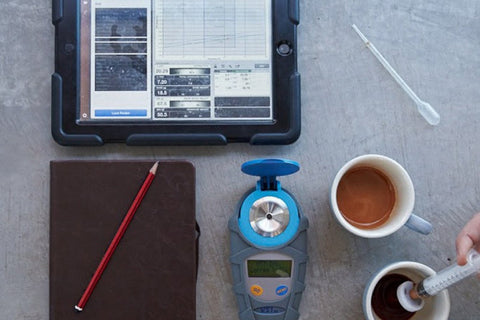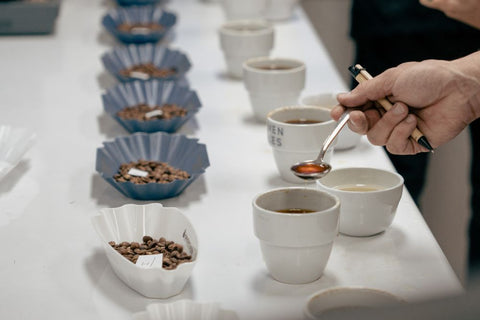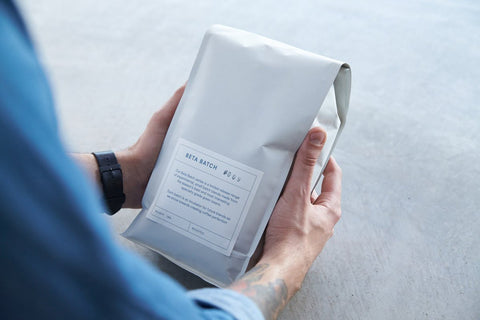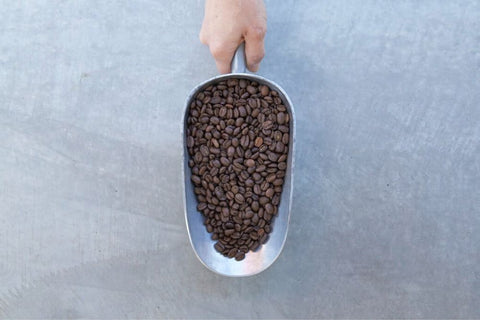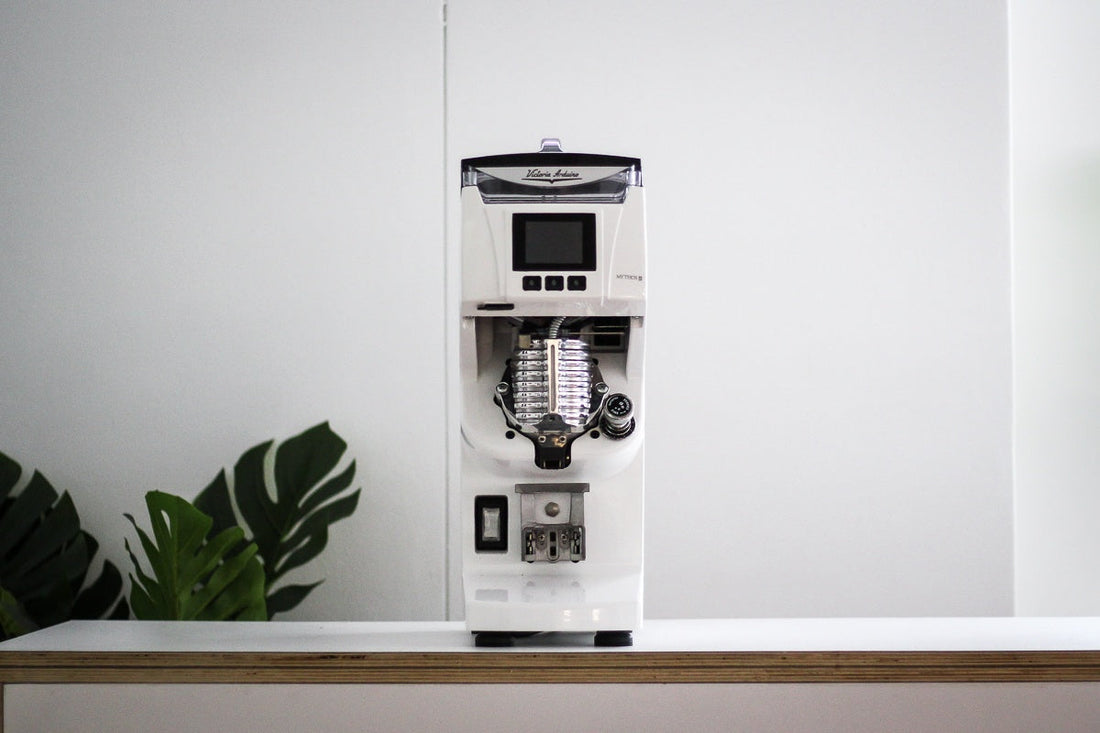The Highs
- Set-and-forget automatic mass dosing (i.e. built-in scales)
- Easier to service than the Mythos 1
- Consistent real world operation
The Lows
- Long dosing time at low RPM settings
- Expensive
- Some grinds back-flow into the hopper
The Bottom Line
This machine is a worthy upgrade from the Mythos 1 in almost every way. We’d love to see the designers improve the ‘tare’ time for grinding.
Mythos 2 Grinder: better than the original?
Sequels tend to fall within two categories. The first kind tries to cash in on the success of the former, tending to follow the same script, with one or two minor nods to innovation (like a clock in a refrigerator). The second kind takes the massive success of the first and eclipses it by refining the old and then adding something no-one else dared before. Like the T-1000 in Terminator 2. If you read no more, read that we believe it fits into comfortably in Category 2: the good kind. That said, there were some issues with the model received (likely because we had a preproduction prototype to test). Before we get into those, let’s first focus on what makes this grinder unique, at least on paper. Within the new Mythos 2 model, Victoria Arduino included a gravimetric dosing system… Which is another way of saying that the scales are built into the grinder.
No longer does a barista need to ‘dial-in’ a timer on the grinder – the machine does that for you.
And this is a significant innovation, and surely one that would have taken years to develop. On paper, we felt that this would help workflow in a café, and the consistency of the served espresso. 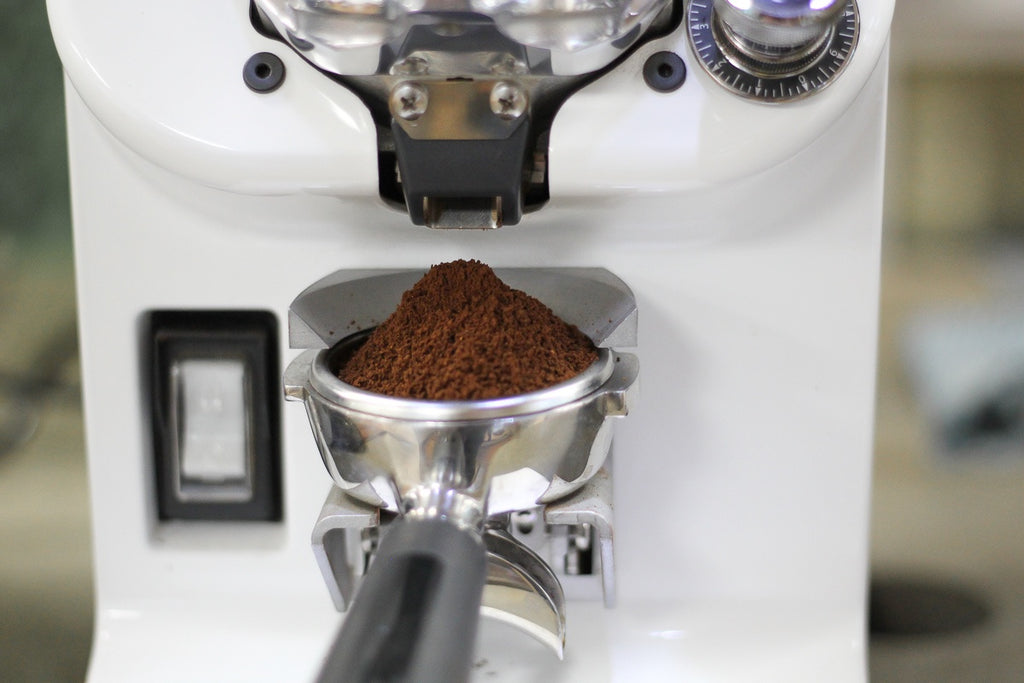 And the fun doesn’t stop there, friends. Included in the model we tested, the ‘Mythos 2 Gravimetric’, was also a burr speed control system. Yes, we were able to modify the burr speed from 400 to 1200rpm. So, on paper, the grinder looks like it’s the best thing since Gaggia was able to produce crema on an espresso. But how does it fare in real world operation? For us, the key questions to answer are:
And the fun doesn’t stop there, friends. Included in the model we tested, the ‘Mythos 2 Gravimetric’, was also a burr speed control system. Yes, we were able to modify the burr speed from 400 to 1200rpm. So, on paper, the grinder looks like it’s the best thing since Gaggia was able to produce crema on an espresso. But how does it fare in real world operation? For us, the key questions to answer are:
- Is the dosing system accurate and reproducible?
- Does changing the RPM do anything valuable (or otherwise) to the coffee grounds?
- How does the unit, with all its bells and whistles, hold up in cafe conditions?
Testing Part 1: Does the Gravimetric Dosing System Deliver?
There were two variables we tested to reach a verdict on this. The first was the obvious one: how does the dose vary grind-to-grind. The second was similar: does accuracy change at different RPM settings? Thankfully, both questions could be answered with one simple graph, shown below.
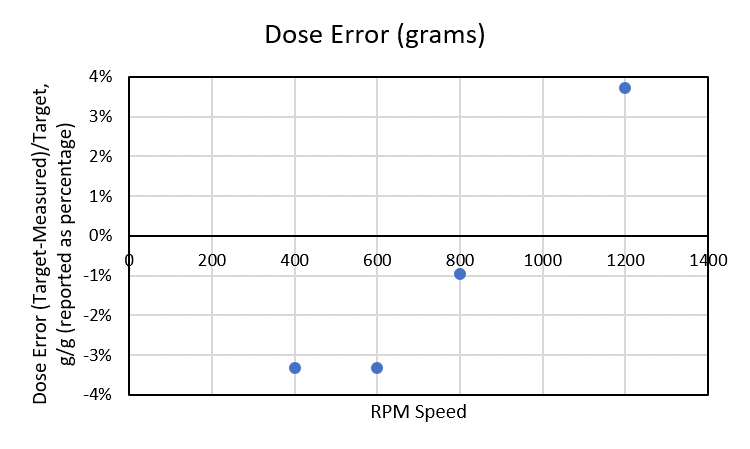
Figure 1: Discrepancy between the ‘set’ dose of coffee vs. the actual dose of coffee from the Mythos 2 (i.e. desired dose setting vs. actual measured dose setting). Result displayed as a percentage error of 21g (the dialled-in-dose). X-axis defines the RPM speeds of the Mythos 2.
Firstly, multiple doses at the same RPM speed varied less than 1% at all RPM speeds (thus the error bars can’t display on the graph above!). That is to say, if I got 20.3g on dose 1 at 400RPM, I got either 20.32g or 20.28g, or better, the next time.
It was highly consistent, which is excellent news.
However, we found that, when changing RPM speeds, the accuracy of the dose relative to the target dose varied between + and -4% from the target. This means that if we wanted 21g dosed from the grinder, at 400rpm (lowest speed), we got 20.3g, and at 1200rpm, we got 21.8 grams. This corresponds to about one or two whole coffee beans ground and dosed. In the real world this is likely to be as accurate as can be reasonably achieved. There will always be some delay in mass measurement as it grinds (it is gravity fed after all). To correct this, it’s likely a control algorithm was programmed so as to predict when to shut the motor off, because of this delay. To do this, they’d have used a blend different to the one we used for the tests. That it only resulted in a ‘1-bean-error’, is to be applauded. Truthfully, getting around this minor snag is easy. You simply enter the mass you want dosed, see what it gives you a few times, then simply change the dose to half a gram more, or less than what was actually dosed. Presto, you’ve calibrated your grinder and you should be good to go for the rest of the day. 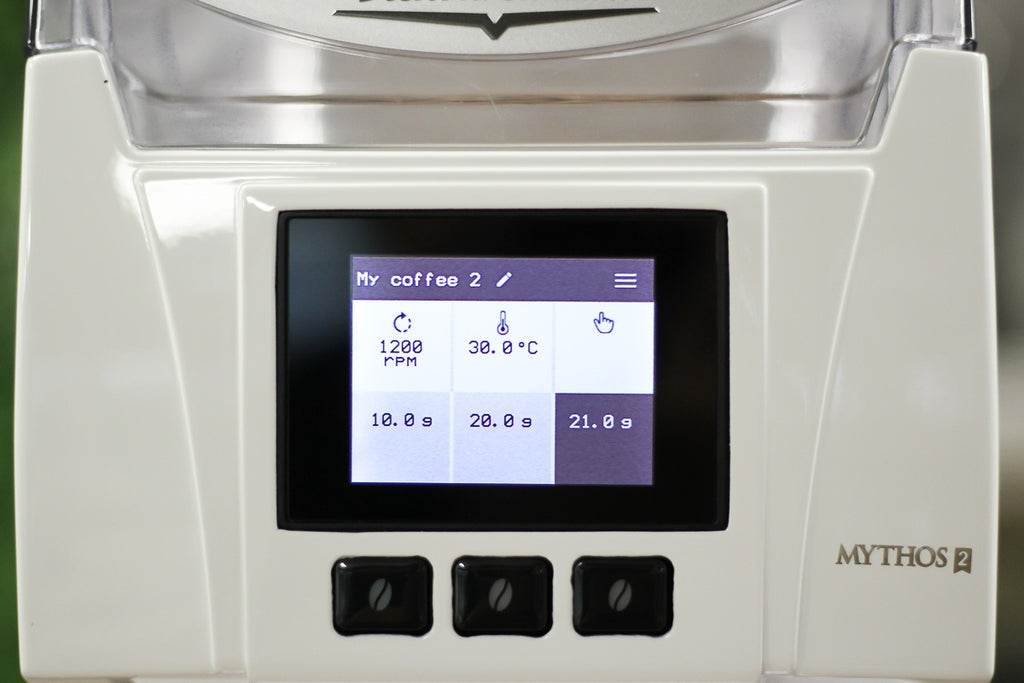
Testing Part 2: What does changing the RPM do to your Coffee?
The effect burr speed had on espresso quality was less clear to us, and required experimentation. We decided to test three things.
- What effect does changing RPM have on dosing speed (accuracy was covered above)
- What effect does changing RPM have on the extraction?
- What is the effect of RPM changes on taste?
One the first point: we found there was a significant impact on dosing speed at different RPM settings. Perhaps this makes sense: faster burr speeds lead to faster grinding, which leads to a faster throughput. Our results are shown below.
Including tare time, grind time ranged from 30 seconds/21g on 400RPM, and 10s/21g for 1200RPM. Yes, if we do the math, if you increase the burr speed by a factor of 3, you get a 3-fold decrease in dose time.
 Figure 2: Effect of RPM on dose time. The decrease in time for a 21g dose follows a natural decay curve
Figure 2: Effect of RPM on dose time. The decrease in time for a 21g dose follows a natural decay curve
And what effect does this have on extraction? It turns out, interestingly, not a whole lot.Brew time averages increased from 24 seconds/35g out (as weighed through the La Marzocco Strada AV-ABR) at 400RPM to 28 seconds/35g out at 1200RPM. This may seem significant, however we found the variation in extraction was ±1.5 seconds across the board, meaning that we sometimes we achieved 26s shots on 400RPM, and 26s shots on at 1200RPM. So, while we observed a linear increase with RPM speed, it was very slight, nearly negligible in real-world operation. It’s more likely the extraction was accelerated due to coffee ground temperature increase as RPM increased.

Figure 3: RPM effect on brew time, with 21g dose out of Mythos 2, 35g out of coffee as produced from La Marzocco Strada AV-ABR
And on the topic of temperature increase of the coffee grounds, it probably comes as no surprise that the higher the RPM speed, the warmer the grind particle temperature. We found a linear increase in temperature as RPM speed was increased, starting at 42C at 400RPM, and 48C at 1200RPM.
Testing Part 3: What impact does RPM have on taste?
We graphed some representative tasting results on the spider graph shown in Figure 4, below. Most of the trends were complex, though there are some conclusive statements we can make. Overall, we found that trends were non-linear, in that what was high at 400RPM wasn’t necessarily low at 1200RPM.
Generally, we found that acidity was maximized at medium RPM settings (e.g. 800RPM), but was counteracted by reducing the sweetness and overall balance of the coffee.
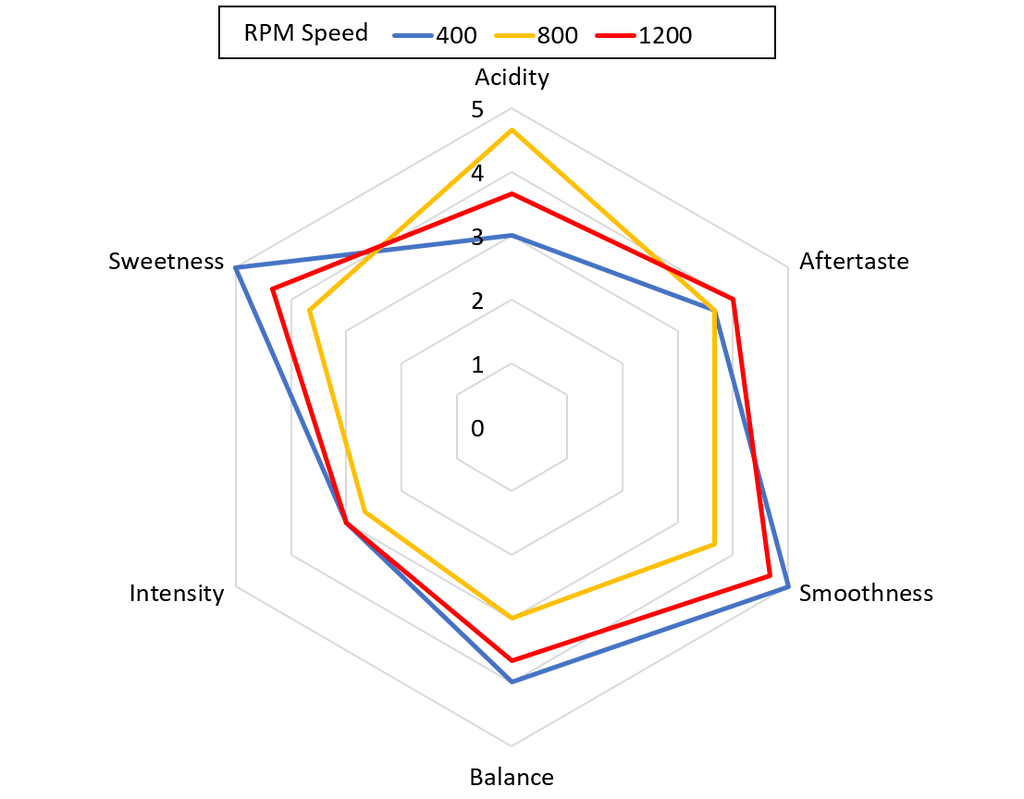 Figure 4: Taste results of changing RPM on espresso qualities. For example, acidity is lower at 400RPM. )
Figure 4: Taste results of changing RPM on espresso qualities. For example, acidity is lower at 400RPM. )
Interestingly, while we observed good quality espresso at the extremes of RPM operation, (i.e. at 400RPM and at 1200RPM), we found that there was no ‘one RPM to rule them all’. Any RPM change tended to increase or decrease other properties. The interim speeds (i.e. higher than 400RPM and lower than 1200RPM) tended to sacrifice either a pleasant aftertaste or sweetness for acidity and smoothness, or vice-versa. So what does this mean? If you love acidity more than anything else, we found 800RPM makes the most sense. It just comes at a cost of overall balance and sweetness.
If you want to maximize sweetness and overall balance, you’ll certainly want to use the 400 or 1200RPM speed settings.
Testing Part 4: Does the Mythos 2 deliver in real world café settings?
It has to be said, with the preproduction version we had: there was almost always a 7 second delay while the Mythos 2 ‘tared’ (i.e. re-zeroed) the group handle.
That’s 7 seconds standing around doing nothing, and is effectively wasted time.
Presumably one could get around this by having multiple handles for the same group, but that may not be an option for most cafes. Our understanding is that this will be changed by the time the production version is out (our sources claim down to 4 seconds): and we most certainly hope so. We’d prefer 3 seconds or less like can be programmed into our La Marzocco Strada AV-ABR.
Servicing.
The biggest issue we had with the original Mythos was that it was painfully difficult to service. Getting into the guts of the grinder, to access the motor and micro switch was a bit like the rebel alliance trying to fly into the heart of the death star. Thankfully, this has been fixed with the Mythos 2, with access via the chassis rather than the undercarriage. Changing the clump crusher was also a breeze, as it now comes with its own housing.
Adjustment
Another major feature of the Mythos 2 is the ‘on-the-fly’ adjustment of the grind settings. With preset-modes assigned to one of three buttons, one can make rapid shifts in grind setting. In other words, we could have 21g dosed out at 600RPM for one setting, and 18g at 1200RPM for another – perhaps to adjust between Espresso and Ristretto settings. The adjustment is set, and ready to go. That said, if one wanted to change the burr distance, you still have to do that manually. However, as we observed in our tests, there may be flavour-based reasons that one may want to rapidly change from 600RPM to 1200RPM.
Appearance
Function is great, but how does it look? Well, we’ve not always been fans of the looks of the Mythos (though no doubt beauty is in they eye of the beholder), and these trends continue with the Mythos 2. That said, we got a white and black one to test, and it kind of looks like a stormtrooper from Star Wars. 
Who is the Mythos 2 Grinder best suited for?
This grinder is a dream for the barista that wants to be able to achieve slight tweaks in flavour rapidly. The barista who wants to achieve consistency without needing to manually weigh grinds over the course of a given day. But, let’s face it, the machine is expensive. For the model we tested, the top of the line Mythos 2 'gravimetric' has an RRP of $5460AUD, which is $2000AUD more expensive than the Mythos 1. If the extra precision is not a big deal to you or the time it takes per shot doesn't fit your workflow, then a timer-based Mazzer, Mythos 1 or Anfim SPII is probably a better choice. Ultimately, in our opinion, with the Mythos 2, you get what you pay for. A sophisticated, well thought out tool, that has the potential to improve your throughput and refocus a baristas attention away from the scales, and back onto coffee quality.
Comparing grinders? Take a look at our guide to the best commercial espresso grinders, or find out about our equipment options for cafes . Click here to see the results of our tests on grind by weight grinders as we ask the question: are gravimetric grinders better? For more on the work of the Coffee Science & Education Centre, click here




